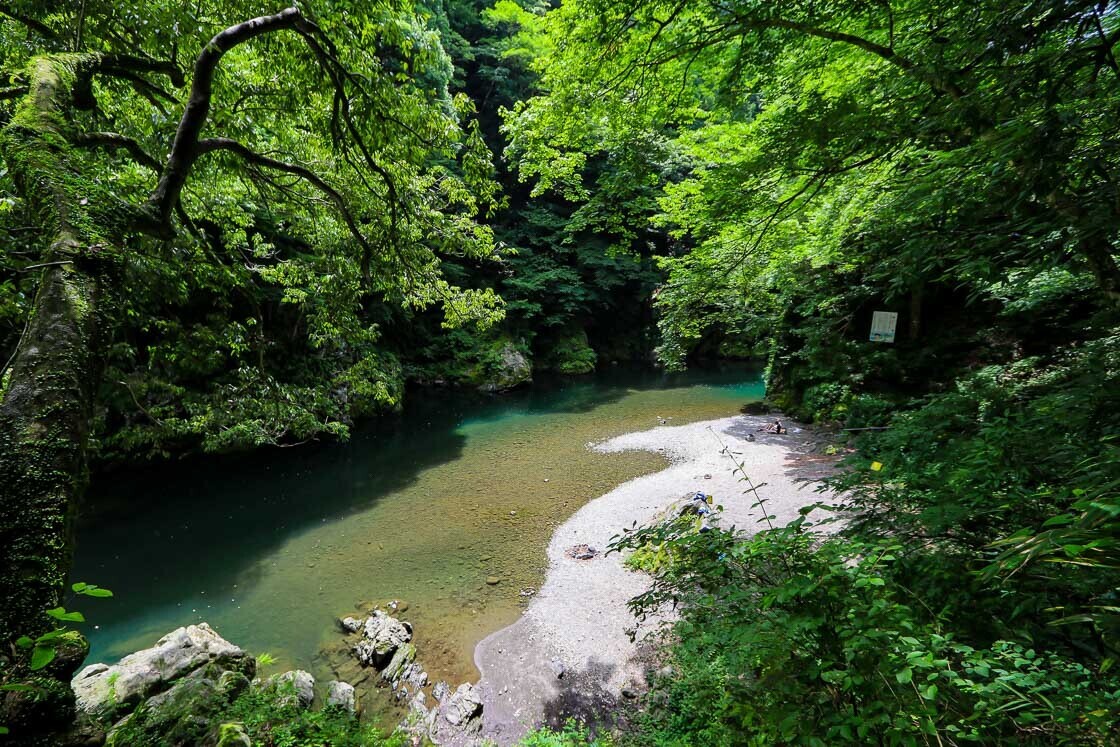Exploring Tokyo’s hidden oasis
The mountainous region of Okutama lies in western Tokyo and can be conveniently accessed from central Tokyo by train in two hours or less. Okutama is by no means the metropolitan, bustling city commonly associated with the name Tokyo.
Most of Okutama is within the Chichibu-Tama-Kai National Park and the majority of it is covered by mountains and forests. As such, visitors can look forward to peace and quiet, an abundance of nature and a multitude of outdoor activities. In other words, Okutama is the perfect escape from central Tokyo.
For my maiden visit, I went for some of the best activities Okutama has to offer like forest therapy and wasabi farming. Many of the activities I participated in had a recurring theme of engaging my five senses to fully appreciate the present, which compelled me to slow down. My overnight trip to Okutama was like an extended mindfulness retreat, which was extremely refreshing and made me reluctant to return to the city.




Day 1
I arrived at Okutama Station, where my overnight trip began. The plan was to visit the Nippara Limestone Cave first, followed by a forest therapy walk, and then head to my accommodation.
The cavernous Nippara Limestone Cave is where visitors can be transported into the past to see unique rock formations, ancient stalactites, stalagmites and columns. It is said that these stalactites take on average about 200 years to grow about three centimeters, while the stalagmites take about 400 years!

The cave maintains an average temperature of about 11 degrees Celsius all year round. Visitors follow a path which winds through the cave and there are signs pointing out some of the more interesting rock formations.


Given that the large majority of Okutama is covered by mountains, forests and numerous giant trees, it was a no-brainer that one of my activities here was to be forest therapy. The aim of forest therapy is to spend time immersed in nature and use our senses to anchor us to the present surrounded by greenery. This is said to help us relax and thus improving our minds and health.
With that in mind, I met my knowledgeable guide, Mr. Masuzawa who speaks excellent English, at Okutama Station and off we went on our forest therapy walk. The first half of our walk brought us from the station and along the river to the Toke Trail rest station. Along the way, my guide talked about Okutama and its history, introduced the local flora and explained the finer points of Shinto, the Japanese indigenous religion. I believe this was my first time getting to know the local terrain in such detail.



The Toke Trail rest station was where I had my lunch, which was included in my guided walk, and where the second half of my walk began after lunch. The Toke Trail or Fragrance Road, is Japan's first forest therapy trail which was created specifically for that purpose. The 1.3 kilometer trail is well marked by a wood-chipped path, has numerous aesthetic resting spots which blend into the surroundings, and is also wheelchair accessible.
My guide and I took two hours to walk the short trail at a leisurely pace. It was such a luxury to be able to take my time, enjoying the bird and insect calls, touching and smelling the different herbs and plants along the trail under the expert tutelage of my guide.







It was late afternoon by the time I arrived back at Okutama Station and headed to Arasawaya Ryokan, my accommodation which is a stone's throw away. The homely inn is run by the Arasawa family and is currently helmed by the 3rd and 4th generations. One of the highlights of my stay was the folklore telling time in Japanese after dinner by the elder Mr. Arasawa, who has published three books about Okutama's folklore.




Day 2
The plan for my second day was to go for a short walk at a nearby gorge, then a wasabi experience, and finally end my trip at a sake brewery.
Located in what is said to be one of the most beautiful valleys in Okutama, Hatonosu Gorge offers views of the Tama River cutting through tall cliffs and large, unique shaped rocks. A walking trail leads through the rocks parallel to the river, and that was what I did. My morning walk brought me a little ways down the main trail before I did a U-turn and headed back to see a shrine and a couple of waterfalls not far from my starting point.





It was mid morning by the time I arrived at the meeting point for my wasabi experience. Wasabi is a well known Japanese condiment, which is typically made into a paste and commonly paired with sushi. Wasabi plants are traditionally grown in sandy, rocky beds with constant streams of fresh, clean water, but it can also be grown in soil only.
Incidentally, Okutama is one of the top three wasabi growing regions - specifically where the wasabi plants are grown in rocky beds with flowing water - in Japan. Not only that, Okutama wasabi has a history dating back to the Edo Period (1603 - 1868) and was also presented to the then ruling government.

Before the activity, I wrongfully assumed that I would be visiting an ordinary vegetable farm growing wasabi to see how the plant is grown and harvested. However, never have I been glad to be so wrong, and the activity was a multi-sensory experience which blew me away. Firstly, the short hike through the woods to get to the wasabi stone terraces along the river was quite magical. Secondly, the educational experience included seeing how and where the wasabi plants are grown, a hands-on opportunity to plant and harvest wasabi, and closed with having a rice bowl topped with freshly grated wasabi.
Wasabi is traditionally grated on sharkskin, but my guide brought out three different metal wasabi graters explaining that modern metal graters are comparable to sharkskin, and not only that, they tend to also be more hygienic. The different metal graters yielded wasabi paste of different textures and levels of stickiness, which in turn resulted in differences in spiciness and flavour profile. The three samples I tried had a very nice, fresh and almost floral fragrance. While it was definitely spicy, the freshly grated wasabi also had a bright and clean taste, and was neither overpowering nor did it linger too long on my tastebuds.







The wasabi experience took about 2.5 hours, which flew by in a blink of an eye, and I found myself back at the meeting point once more. From there, I made my way to the nearby Ozawa Brewery, a sake brewery established in 1702 and the only one in Okutama. The brewery's brand is Sawanoi, named after the area the brewery is located in - Sawai - and it is typically used to refer to the brewery.
Brewery tours are held at Sawanoi several times a day, and reservations are recommended. The 30 minute tour takes one through the different warehouses or kura built in the different periods, starting with the one built when the brewery was established, as well as explaining the sake making process. An excellent English pamphlet which details the process of sake making is available. One interesting part of the tour was seeing the well which supplies the water used for making sake. It's not everyday you get to see the source of the water used at a sake brewery.
Due to the ever-changing status of the domestic covid situation, it is advisable to check if tours are being conducted on the official website before going. Tours are currently suspended at the time of the publication of this article (September 2022).




In addition to the brewery tour at Sawanoi, a major highlight is the picturesque riverside garden across the road from the brewery buildings. A sake tasting bar is available at the riverside garden and allows non-driving visitors to enjoy a nice selection of Sawanoi's delicious sake at very affordable prices. How the system at the sake bar works is that your first purchase includes a small sake cup, and subsequent pours in the sake cup are discounted. Definitely a brilliant idea of trying before committing to buying a whole bottle.
Restaurants, a cafe and a sake shop round up the businesses in the garden, and there is plenty of outdoor sitting along the river to enjoy the food and drink. It was also not uncommon to see visitors buying a whole bottle of sake and drinking it in the garden there and then. Those looking for more than just eating and drinking leisurely, there are also walking trails down to the river and a bridge across the river, from where walking paths lead to a small temple and one of the two museums operated by the brewery. But for me, I was happy to simply eat and drink in comfort by the river.


The visit to Sawanoi concluded my trip to Okutama, Tokyo's diamond in the rough. I had such a great time here, that two days almost seemed too short. But, knowing that Okutama is only less than two hours away from central Tokyo puts it high on the list of where I can go in a hurry for when I want a nature recharge. Till we meet again, sooner rather than later!

Access
The Okutama region can be accessed by train from central Tokyo. From Shinjuku Station or Tokyo Station, take the JR Chuo Line and transfer to the JR Ome Line at Ome Station to the terminus, Okutama Station. The one way journey takes less than 2 hours from Shinjuku Station or about 2 hours from Tokyo Station, and costs around 1000 yen.
Many of the spots visited in this article are within ten minutes on foot from their nearest train stations shown on the map below, while Lake Okutama and the Nippara Limestone Cave can be accessed by buses departing from Okutama Station.

Links
- Okutama Forest Therapy - Official English website about Okutama forest therapy
- Arasawaya Ryokan - Official English website of the accommodation in this article
- Wasabi Experience - Official English website of the wasabi activity
- Ozawa Brewery - Official English website of the Sawanoi sake brewery


